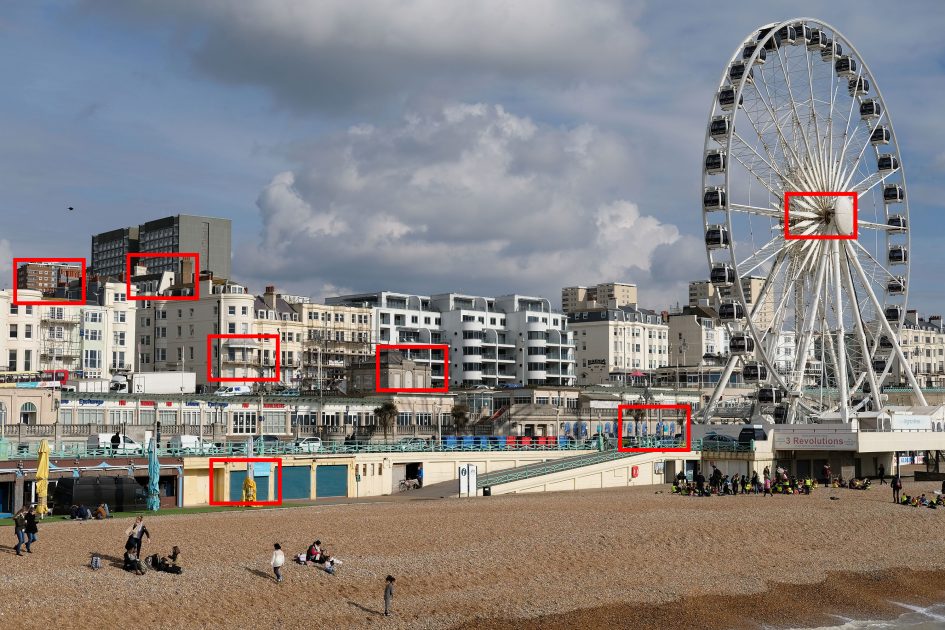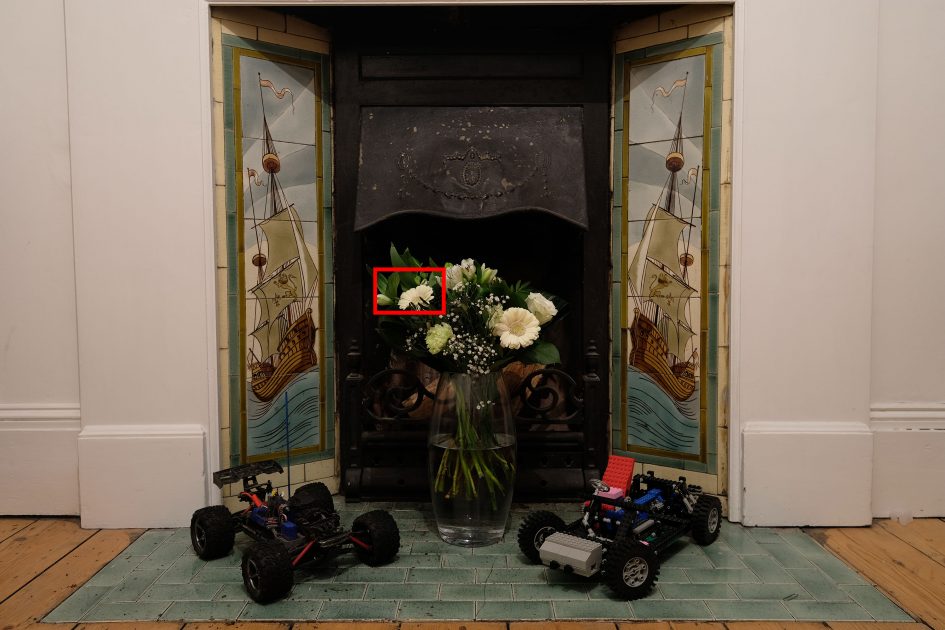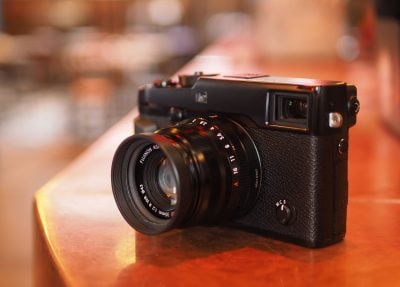Fujifilm X-Pro2 review
-
-
Written by Gordon Laing
Quality
To compare the real-life quality between the Fujifilm X-Pro 2 and the Fujifilm XT1, I shot this scene with both cameras moments apart using the same lens, the XF 35mm f2 set to f5.6 for optimal sharpness. Both cameras were also set to their base sensitivity of 200 ISO and metered the same exposure. Until the X-Pro 2 is supported by Adobe Camera RAW, I’m comparing JPEGs here straight-out-of-camera.

Below you’re comparing 100% crops from the new 24 Megapixel X-Trans III sensor of the X-Pro 2 in the left column against the old 16 Megapixel X-Trans II sensor employed by the XT1 and many previous Fuji X bodies. Both sensors share the same APS-C area, so in order to squeeze 50% more pixels into it, the X-Pro 2 has simply made them smaller. An increase of 50% in total pixels sounds like a lot, but in actual linear resolution the boost represents a little over 20% horizontally and vertically. The old sensor sports 4896×3264 pixels compared to 6000×4000 pixels on the new one.
So what does the boost in resolution get you in practice? Judging from the crops below, you’ll only notice it in the very finest details. Look closely and you’ll see the X-Pro 2 is certainly resolving finer detail than the XT1, most notably in fencing, railings, grills, brickwork and the lettering on distant signs, but in other areas it’s hard to tell the difference. The good news though is the extra detail is there if you look for it, and the unique colour filter array continues to do a good job at avoiding moire even without a low pass filter.
The bottom line is the X-Pro 2 maintains the satisfyingly crisp, moire-free output of previous models while resolving a little more detail, which should keep the Fuji faithful happy. Once again the increase in detail isn’t huge, but it’s there given the right subject and should allow you to output at larger sizes before the quality is compromised. Numerically at 300dpi, the X-Pro 2 lets you to output 2in taller and 3in wider than older models with the X-Trans 2.

Above: Fujifilm X-Pro2 and XF 35mm f2 at f5.6 (left), Fujifilm XT1 and XF 35mm f2 at f5.6 (right)

Above: Fujifilm X-Pro2 and XF 35mm f2 at f5.6 (left), Fujifilm XT1 and XF 35mm f2 at f5.6 (right)

Above: Fujifilm X-Pro2 and XF 35mm f2 at f5.6 (left), Fujifilm XT1 and XF 35mm f2 at f5.6 (right)

Above: Fujifilm X-Pro2 and XF 35mm f2 at f5.6 (left), Fujifilm XT1 and XF 35mm f2 at f5.6 (right)

Above: Fujifilm X-Pro2 and XF 35mm f2 at f5.6 (left), Fujifilm XT1 and XF 35mm f2 at f5.6 (right)

Above: Fujifilm X-Pro2 and XF 35mm f2 at f5.6 (left), Fujifilm XT1 and XF 35mm f2 at f5.6 (right)

Above: Fujifilm X-Pro2 and XF 35mm f2 at f5.6 (left), Fujifilm XT1 and XF 35mm f2 at f5.6 (right)
Scroll down for my Fujifilm XT2 noise results or tab to my Fujifilm XT2 sample images.
Fujifilm X-Pro 2 noise
To compare noise levels under real-life conditions, I shot this scene with the Fujifilm X-Pro 2 and Fujifilm XT1 at each of their ISO values. I fitted both cameras with the same XF 35mm f2 lens set to f5.6. The full view is pictured below with the red rectangle indicating the area I cropped; note I’m comparing out-of-camera JPEGs here until the X-Pro 2 is supported by Adobe Camera RAW.

Below you’re comparing 100% crops from the new 24 Megapixel X-Trans III sensor of the X-Pro 2 in the left column against the old 16 Megapixel X-Trans II sensor employed by the XT1 and many previous Fuji X bodies in the right column. Both sensors share the same APS-C area, so in order to squeeze 50% more pixels into it, the X-Pro 2 has simply made them smaller. The old sensor sports 4896×3264 pixels compared to 6000×4000 pixels on the new one, so the difference represents a boost of a little over 20% in linear resolution. You saw on the previous page how this allowed the X-Pro 2 to slightly out-resolve fine details compared to the earlier models, but does the smaller pixel size compromise noise and tonal range? The crops below should help answer that question.
First things first: the shots here were taken under constant artificial lighting and the shutter speeds were matched for each ISO value. Judging from the crops below I think it’s apparent the X-Pro 2 is once again slightly out-resolving the XT1, most noticeably in the fine veins on the leafs. But there’s also a slight difference in brightness, with the X-Pro 2 crops looking a little darker than those for the XT1. It’s very subtle, but implies the older XT1 is fractionally more sensitive at the same reported ISO values. The difference could also be down to processing styles, so warrants further investigation.
In terms of visible noise I’d say both cameras are fairly well-matched at the pixel level when viewed at 100% up to 1600 ISO – and up to this point they’re both delivering pretty clean output too with lots of detail. At 3200 and 6400 ISO some noise becomes visible on both cameras although I’d give a very slight edge to the earlier XT1 but the situation reverses at 12800 ISO and above; that said neither look great at this point.
So despite that minor drop in comparative sensitivity (or processing difference), I’d say Fujifilm has got away with increasing the pixel count and devoting more of them to phase-detect AF duties without compromising noise levels compared to the older models with X-Trans II sensors. So while the X-Pro 2 doesn’t improve noise at high ISOs compared to the XT1 in this test, it’s no worse at the pixel level that always comes as some relief when the resolution is increased.

Above: Fujifilm X-Pro2 (left), Fujifilm XT1 (right) all with XF 35mm f2 at f5.6 in JPEG at 100 ISO

Above: Fujifilm X-Pro2 (left), Fujifilm XT1 (right) all with XF 35mm f2 at f5.6 in JPEG at 200 ISO

Above: Fujifilm X-Pro2 (left), Fujifilm XT1 (right) all with XF 35mm f2 at f5.6 in JPEG at 400 ISO

Above: Fujifilm X-Pro2 (left), Fujifilm XT1 (right) all with XF 35mm f2 at f5.6 in JPEG at 800 ISO

Above: Fujifilm X-Pro2 (left), Fujifilm XT1 (right) all with XF 35mm f2 at f5.6 in JPEG at 1600 ISO

Above: Fujifilm X-Pro2 (left), Fujifilm XT1 (right) all with XF 35mm f2 at f5.6 in JPEG at 3200 ISO

Above: Fujifilm X-Pro2 (left), Fujifilm XT1 (right) all with XF 35mm f2 at f5.6 in JPEG at 6400 ISO

Above: Fujifilm X-Pro2 (left), Fujifilm XT1 (right) all with XF 35mm f2 at f5.6 in JPEG at 12800 ISO

Above: Fujifilm X-Pro2 (left), Fujifilm XT1 (right) all with XF 35mm f2 at f5.6 in JPEG at 25600 ISO
I hope to repeat this comparison with RAW files when noise reduction is turned-off to see what’s really going on behind the scenes. In the meantime head over to my Fujifilm X-Pro 2 sample images or tab back to my verdict.




